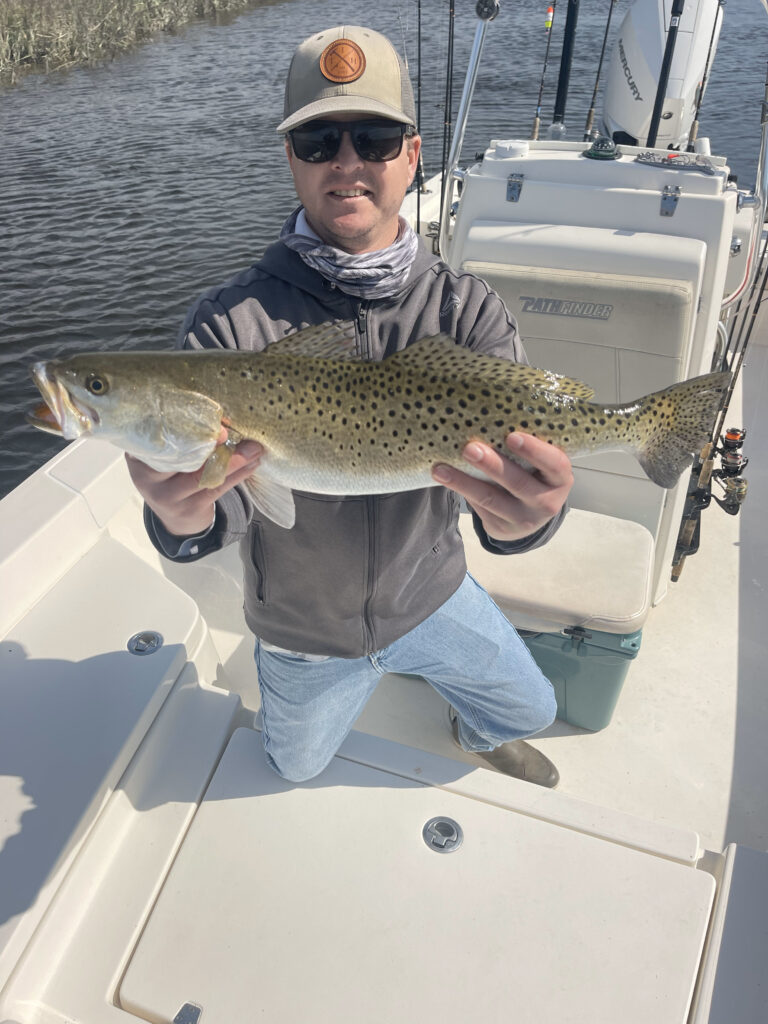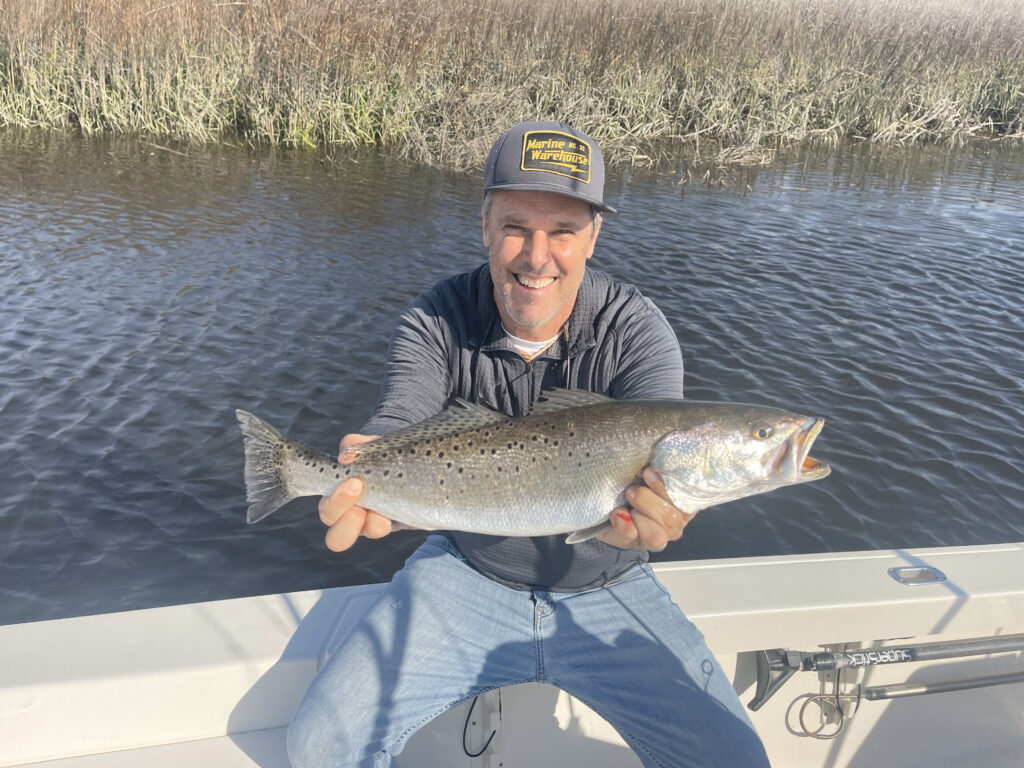Tidelines – April 2024
Team building at Fisherman’s Post, as you can imagine, takes form in fishing trips, so with a new Sales Manager on the team, going fishing with Capt. Tim Disano, of Tidelines Charters out of Ocean Isle, seemed like a great way to further acclimate Chris Rogers to the Fisherman’s Post community.
A low, incoming tide on our Friday morning gave Tim possibilities, so our plan was to first try for some shallow water redfish, and then transition over to searching for the bigger spring trout that populate the Ocean Isle area.

Chris Rogers, Sales Manager of Fisherman’s Post, with a speckled trout caught drifting live shrimp across a creek mouth. He was fishing with Capt. Tim Disano of Tideline Charters out of Ocean Isle.
Not long after heading south underneath the Ocean Isle Bridge, Tim spotted red drum in an area just off the ICW where a school had been holding for a couple of weeks. We could see several pushes and clear movements back and forth along a section of the bank, and while we chased them quietly and from afar, we couldn’t get them to eat anything.
These fish weren’t spooked, just uninterested in any of the jigs (mostly 3” soft plastic paddle tails) or topwaters that we threw out in front of these moving schools, so when Tim tried a live shrimp with the same results, moving on, even though we were clearly seeing fish, was a bit of a struggle but a necessary decision. We needed to turn to trout before too much tide came in.
“A lot of our really shallow creeks in the backs of the marsh, as the creek makes a bend, the current over time is going to dig out a deeper section,” Tim explained as we half idled and half drifted up a creek. “In some of the creeks, the holes are deeper than others. Most of the ones we are going to fish today go from about two-feet deep to close to nine-foot deep in the holes.”
“Coming out of the winter pattern,” he continued, “the trout will hold there. There will be bait for them to eat.”
At our first stop, we picked up a couple of specks, all easily keepers but smaller than the size Tim was looking for, so we made a move to a nearby creek with a slightly deeper hole surrounded by shallow water.
“These fish are used to not only being in a spot that’s good for them for finding something to eat but also a spot where they’re protected,” Tim said. “In these really shallow creeks, especially ones with a sandy bottom, they’re visible to birds and others that might try to harm them, so on these lower tides, if they do decide to stay in those areas, most of the time they’re going to be in the deeper water. It gives them the type of cover and positioning they need to be safe and ambush food.”
Chris was told to cast his float rig with a live shrimp out a little to the left and in a seam that would drift his bait across an adjacent creek mouth, and my cast was to go more to the right and hold just off the bank.
Chris’ float went under, and he brought in a 3-pound class trout. My float stayed quiet, so Tim had me reel in a little to position my bait further off the bank. Less than three minutes later, my float quickly disappeared, and I, too, brought in a 3-pound speck.
“Most of the trout are coming from the shallower side and they’re going to feed on the deeper side,” Tim explained. “Your bait was just a few feet too far in one direction. A minor adjustment can be all it takes.”
Meanwhile, Chris was battling with overcoming childhood issues, specifically his freshwater largemouth bass days of setting the hook like Bill Dance.

Gary Hurley, of Fisherman’s Post, with one of the many keepers caught using live shrimp under a float. He was fishing in a shallow creek near the inlet with Capt. Tim Disano of Tideline Charters.
His float went under, but after an attempted big hookset, the line never came tight. His next bait, too, went under, and again an impressive hookset came back empty.
“Unfortunately, it’s just innate,” Tim said sympathetically as he pulled another shrimp out of the livewell. “It doesn’t matter who it is, when you see your float disappear, you get excited. We definitely try to avoid setting the hook because of the super light tackle we’re using, as well as the smaller hooks, in order to keep the shrimp presented well, and that paired with the fact that trout have really soft mouths, you drastically reduce your chances of catching a fish when you try to set the hook.”
Chris’ shrimp went to the same spot where his last two had disappeared, and Tim continued to coach, “You want to pick up our slack as quick as you can, but you want to let the fish set the hook himself.”
The float that Chris was watching intently again disappeared, and this time he followed instructions by reeling quick but only lifting the rod to a 45-degree angle, the raise of the rod more to help clear the slack than to set the hook. The line came tight, and while we saw the telltale head shakes, this fish stayed down deep and pulled more drag and went on more runs than any of our previous fish.
With the prospect of a bigger fish, Tim had me reel in while he grabbed the landing net. Chris took his time, knowing that the same variables of a small hook and a soft mouth meant he couldn’t get anxious and try to force the fish in. Soon we were celebrating our biggest trout of the day, a speck threatening to go five pounds, so we put him in the livewell to weigh at Sheffield’s.
Springtime is when you find bigger trout and a better class of fish in the Ocean Isle area. Areas in the fall that hold 16-18” fish will offer 19-21” fish in the spring, and Tim will be on this bite into May before he transitions to red drum, black drum, and sheepshead.
You can find more information on Capt. Tim Disano, of Tideline Charters, at www.tidelinecharterfishing.com, or call him directly at (910) 279-2020.
Chris’ trout didn’t quite make the 5-pound mark needed for a citation, but then that’s just reason enough to start planning another team building adventure, perhaps a red drum trip so Chris can let out his inner Bassmaster Classic.





